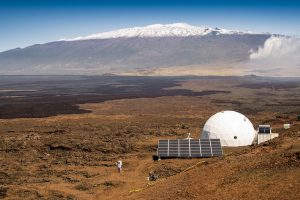
Well, not exactly. It actually just went to a remote location on Hawaii’s Mauna Loa volcano, where an 8-month simulated mission on Mars recently came to a close. The Hawaii Space Exploration Analog and Simulation (HI-SEAS) facility “is a planetary surface exploration analog site at ~8500 feet on the Mauna Loa side of the saddle area on the Big Island of Hawaii,” according to a post on the HI-SEAS website. You can learn more about the missions at hi-seas.org
Faculty Affiliate of the IISBR, Dr. Pete Roma, is among the team of Scientists studying the six-person HI-SEAS Crews as part of a comprehensive research program supported by the National Aeronautics and Space Administration (NASA).

Photo by Neil Scheibelhut, HI-SEAS, University of Hawaii
So what role did Salivary Biosicence play on “Mars”? Dr. Roma explains: “We take regular saliva samples throughout all HI-SEAS missions in order to elucidate the neurohormonal mechanisms involved in group cohesion, team performance, and biopsychosocial adaptation over time in mixed-gender Crews in isolated, confined, and extreme (ICE) environments. A better understanding of how these natural mechanisms operate in ICE environments can help mission planners manage the inherent risks of long-duration space exploration, while the underlying scientific knowledge can ultimately support efforts to enhance cooperation and group cohesion in a variety of social and organizational contexts on Earth, including military, business, healthcare, and education.”
Analysis of saliva samples is administered by IISBR’s world-renowned staff, providing the knowledge and skill required to maintain sample integrity. IISBR’s advice and protocols ensure that high quality biological data are delivered, making accurate conclusions possible. “The IISBR’s expert handling of these irreplaceable samples has been critical to the success of this unique and operationally challenging field research.”
